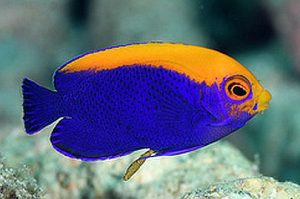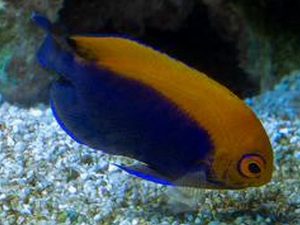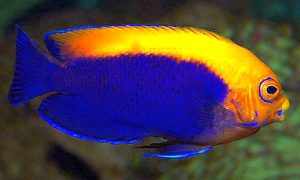The Brazalian Flameback Angelfish (Centropyge aurantonotus) known to tropical fish keeping enthusiasts as the Flameback Angelfish, Flameback Pygmy Angelfish, Caribbean Flameback Angelfish, or Fireball Angelfish occurs from the lesser Antilles and Curacao in the Netherlands Antilles, and the northern coast of South America from Venezuela to southern Brazil.
Brazalian Flameback Angelfish are a shy dwarf species that can be found at depths between 50 and 985 feet along rock and rubble strewn areas of the reef where they feed on algae and sponges. They are commonly found around isolated patches of staghorn coral (Acropora cervicornis) in small groups or swimming alone.
The Brazalian Flameback Angelfish (Centropyge aurantonotus) are similar in color and shape to the African Flameback Angelfish (Centropyge acanthops), the most obvious difference being the dark blue caudal fin that Centropyge acantihops lacks.
Brazalian Flameback Angelfish have an oval, laterally compressed body with a short snout and a small mouth. They have a blue body with bright golden yellow markings over the head and dorsal area, and a blue ring around the eyes. Visual determination of sex is not possible based on coloration but since Centropyge aurantonotus are protygenous hemaphrodites, larger individuals are considered to be males.
Although Brazalian Flameback Angelfish are ideally suited for reef tanks and may occasionally pick at meaty corals like Cynarina spp. or Trachyphyllia spp., they normally do not bother non-sessile invertebrates like crabs or shrimp, and will leave clam mantles alone.
Brazalian Flameback Angelfish are best housed in a mature reef aquarium of at least 30 gallon capacity with plenty of live rock for grazing on microalgae and diatoms; arranged into caves, crevices, and overhangs for them to hide among. A shy species, they require multiple hiding spaces until they establish a territory and feel secure enough to come out into the open areas of the tank.
No successful breeding’s of the Brazalian Flameback Angelfish in an aquarium environment have been reported.
Like other angelfish species, Centropyge aurantonotus lays pelagic eggs and has pelagic larvae. The spawning ritual usually occurs at dusk and the eggs are left to float in the water column. At St. Helena Island, the Brazalian Flameback Angelfish (Centropyge aurantonotus) naturally hybridizes with Resplendent Angelfish (Centropyge resplendens) where it appears that an established hybrid population of the Brazilian Flameback and resplendent angelfish has developed into a very unique fish; the Resplendent Fireball Angelfish.
In the wild, the Brazalian Flameback Angelfish feeds mainly on algae and sponges, however, it also eats the tiny organisms that live in the algae. In an aquarium environment, their diet should include a variety of meaty foods including Spirulina, marine algae, a high quality commercial angelfish preparation, and Mysis or frozen shrimp. The will also accept algae flakes or pellets and should be fed small amounts three times or more a day, even with natural foods present.
Although not common, Brazalian Flameback Angelfish (Centropyge aurantonotus) are available to tropical fish keeping enthusiasts from a variety of sources online and from local tropical fish shops. The lack of demand for Brazilian Flameback Angelfish can be partially attributed to the widespread availability of the African Flameback Angelfish which is considerably cheaper, much more common, and considered by some to be more “reef safe”.
Brazilian Flameback Angelfish in the 1″-2.5″ size will cost about $300.00 vs $99.00 for the same size African Flameback.
Minimum Tank Size: 30 gal
Aquarium Type: Reef compatible with caution
Care Level: Easy
Temperament: Semi Aggressive
Aquarium Hardiness: Hardy when acclimated
Water Conditions: 68 to 82°F, SG 1.020-1.027, pH 8.0-8.5, sg 1.020-1.027
Max. Size: 3″
Color Form: Blue, Orange
Diet: Omnivore
Compatibility: Community
Origin: Caribbean, Brazil
Family: Pomacanthidae
Lifespan: 15 years
Aquarist Experience Level: Intermediate





